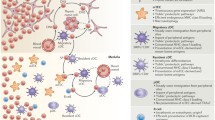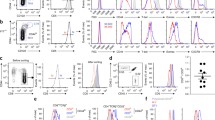Abstract
The role of self-antigen recognition in the development of T and B cells of the adaptive immune system has been studied in several different ways. We have shown that CD4 T cells are selected on selfpeptide:self-MHC class II ligands, and in the periphery, they are sustained by contact with the same or similar ligands. We have also observed that B cells are positively selected on unknown and presumed self-ligands. We have used this information to explore autoimmune diseases as well. Finally, we have recently identified the innate immune system as playing a crucial role in regulating expression of costimulatory molecules that are required for induction of adaptive immune responses.
Similar content being viewed by others
References
Liu Y, Janeway CA, Jr.:Cells that present both specific ligand and costimulatory activity are the most efficient inducers of clonal expansion of normal CD4 T cells. Proc Natl Acad Sci USA 1992;89: 3845–3849.
Lemaitre B, et al.: The dorsoventral regulatory gene cassette spatzle/Toll/cactus controls the potent antifungal response in Drosophila adults. Cell 1996;86: 973–983.
Medzhitov R, Preston-Hurlburt P, Janeway CA, Jr.: A human homologue of the Drosophila Toll protein signals activation of adaptive immunity [see comments]. Nature 1997;388:6640:394–397.
Medzhitov R, et al.: MyD88 is an adaptor protein in the hToll/IL-1 receptor family signaling pathways. Mol Cell 1998;2:253–258.
Medzhitov R, Janeway CA, Jr.: Innate immunity: the virtues of a nonclonal system of recognition. Cell 1997;91:295–298.
Sant’ Angelo DB, et al.: The specificity and orientation of a TCR to its peptide-MHC class II ligands. Immunity 1996;4:367–376.
Sant’ Angelo DB, et al.: The imprint of intrathymic self-peptides on the mature T cell receptor repertoire. Immunity 1997;7:517–524.
Miyazaki T, et al.: Mice lacking H2-M complexes, enigmatic elements of the MHC class II peptide-loading pathway. Cell 1996; 84:531–541.
Ignatowicz L, Kappler J, Marrack P: The repertoire of T cells shaped by a single MHC/peptide ligand. Cell 1996;84:521–529.
Martin WD, et al.: H2-M mutant mice are defective in the peptide loading of class II molecules, antigen presentation, and T cell repertoire selection. Cell 1996; 84:543–550.
Fung-Leung WP, et al.: Antigen presentation and T cell development in H2-M-deficient mice. Science 1996;271:1278–1281.
Grubin CE, et al.: Deficient positive selection of CD4 T cells in mice displaying altered repertoires of MHC class II-bound self-peptides. Immunity 1997;7: 197–208.
Tourne S, et al.: Selection of a broad repertoire of CD4+ T cells in H-2Ma0/0 mice. Immunity 1997;7:187–195.
Surh CD, et al.: Thymic selection by a single MHC/peptide ligand produces a semidiverse repertoire of CD4+ T cells. Immunity 1997; 7:209–219.
Sant’ Angelo DB, et al.: A molecular map of T cell development. Immunity 1998;9:2:179–186.
Goodnow CC: Balancing immunity and tolerance: deleting and tuning lymphocyte repertoires. Proc Natl Acad Sci USA 1996;93: 2264–2271.
Lam KP, Kuhn R, Rajewsky K:In vivo ablation of surface immunoglobulin on mature B cells by inducible gene targeting results in rapid cell death [see comments]. Cell 1997;90:1073–1083.
Jerne NK: Toward a network theory of the immune system. Ann Immunol 1974;125C:373–389.
Baron JL, et al.: Surface expression of alpha 4 integrin by CD4 T cells is required for their entry into brain parenchyma. J Exp Med 1993;177:57–68.
Wong FS, et al.:CD8 T cell clones from young nonobese diabetic (NOD) islets can transfer rapid onset of diabetes in NOD mice in the absence of CD4 cells. J Exp Med 1996; 183:67–76.
Lafaille JJ, et al.: High incidence of spontaneous autoimmune encephalomyelitis in immunodeficient anti-myelin basic protein T cell receptor transgenic mice. Cell 1994;78:399–408.
Olivares-Villagomez D, et al.: Regulatory CD4+ T cells expressing endogenous T cell receptor chains protect myelin basic protein-specific transgenic mice from spontaneous autoimmune encephalomyelitis. J Exp Med 1998; 188:1883–1894.
Van de Keere T, Tonegawa S: CD4+ T cells prevent spontaneous experimental autoimmune encephalomyelitis in anti-myelin basic protein T cell receptor transgenic mice. J Exp Med 1998; 188: 1875–1882.
Chen Y, et al.: Oral tolerance in myelin basic protein T-cell receptor transgenic mice: suppression of autoimmune encephalo myelitis and dose-depen dent induction of regulatory cells. Proc Natl Acad Sci USA 1996; 93:388–391.
Susan Wong F, et al.: The role of lymphocyte subsets in accelerated diabetes in nonobese diabetic-rat insulin promoter-B7-1 (NOD-RIP-B7-1) mice. J Exp Med 1998;187:1985–1993.
Bellgrau D, et al.: A role for CD95 ligand in preventing graft. Nature 1995;377:630–632.
Griffith TS, et al.: Fas ligandinduced apoptosis as a mechanism of immune privilege. Science 1995;270:1189–1192.
Chervonsky AV, et al.: The role of Fas in autoimmune diabetes. Cell 1997;89:1:17–24.
Zhang ZJ, et al.: Suppression of diabetes in nonobese diabetic mice by oral administration of porcine insulin. Proc Natl Acad Sci USA 1991;88:10252–10256.
Zekzer D, et al.: Inhibition of diabetes by an insulin-reactive CD4 T-cell clone in the nonobese diabetic mouse. Diabetes 1997; 46:1124–1132.
Fugger L, et al.: The role of human major histocompatibility complex (HLA) genes in disease, in Scriver CR, et al. (eds): The Metabolic and Molecular Bases of Inherited Disease. New York, NY, McGraw-Hill, 1995, Chap. 9, pp. 555–585.
Author information
Authors and Affiliations
Corresponding author
Additional information
People whose work is included in this review are as follows: Chuck Annicelli, Joanne Appicelli, Avlin Barlow, Jody Baron, Michael Carrithers, Chaoqun Chen, Alexander Chervonsky, Beth Cohen, Bonnie Dittel, Tori Evans, Jennifer Granata, Fridrika Hardardottir, Xin He, Jon Kaye, Matthew Levine. Yang Liu, Grigori Loysev, Ruslan Medzhitov, Paula Preston-Hurlburt, Eve Robinson, Alexander Rudensky, Derek Sant’Angelo, John Shanabrough, Christophe Viret, Irene Visintin, and Sue Wong
Rights and permissions
About this article
Cite this article
Janeway, C.A. The role of self-recognition in receptor repertoire development. Immunol Res 19, 107–118 (1999). https://doi.org/10.1007/BF02786480
Issue Date:
DOI: https://doi.org/10.1007/BF02786480




